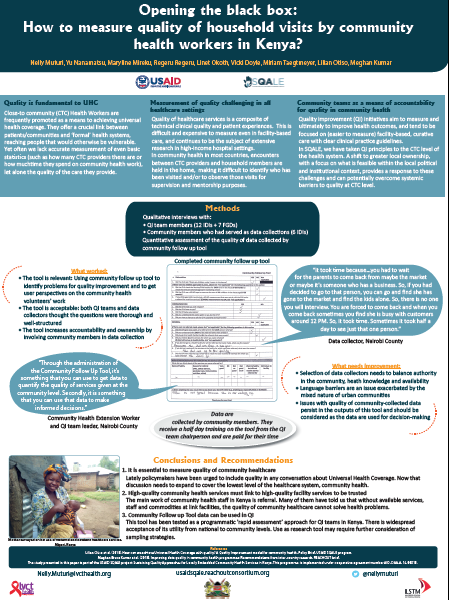Opening the black box: How to measure quality of household visits by community health workers in Kenya?

Quality of care is a key driver of improved health outcomes and effective health service delivery and is evidenced by client satisfaction. In Kenya, there is a growing need and focus on Quality Improvement (QI) at community level to improve uptake of health services. However, there is little evidence on mechanisms to track the quality of services delivered by close-to-community (CTC) health service providers. We sought to capture experiences of using a community home follow up tool to measure the quality of services provided by Community Health Volunteers (CHVs) at household level as a component of a community QI intervention in nine Community Health Units (CHUs) in Nairobi County, Kenya.
The community follow up tool was a program tool introduced to be used by community work improvement teams (WITS) to inform areas of improvement of CHVs work. The tool assessed basic information (household), Maternal Newborn and Child Health (MNCH) activities, communication and referral at household level. The tool was administered by community members not involved in health service provision selected by WITs. Households from where data was collected were purposively selected by the Community Health Extension Worker (CHEW) as having received a CHV visit addressing maternal and child health issues as reported in the previous month. At least two households for every CHV were visited. Qualitative data (nine in-depth interviews and seven focus group discussions) were collected among selected WIT members to find out the ease of use of the tool and quality problems identified from the tool findings.
A majority of the respondents reported the tool to be easy to use and the data collected easily analyzed and interpreted. Challenges related to the use of the tool included arrangement of questions and language (English) instead of local languages. Quality gaps identified included the time CHVs took to conduct household visits (some were reported to take less than ten minutes in a household affecting the quality of services offered), gaps in CHV referral follow up and inaccuracy of the data collected by CHVs.
The Community Follow-Up tool can successfully be used to measure satisfaction with community health services provided by CHVs and can highlight priority areas for quality improvement. Furthermore, using the tool provides an opportunity to identify gaps in CHV capacity allowing support supervision and training to be tailored to their needs with the goal of achieving universal health coverage.